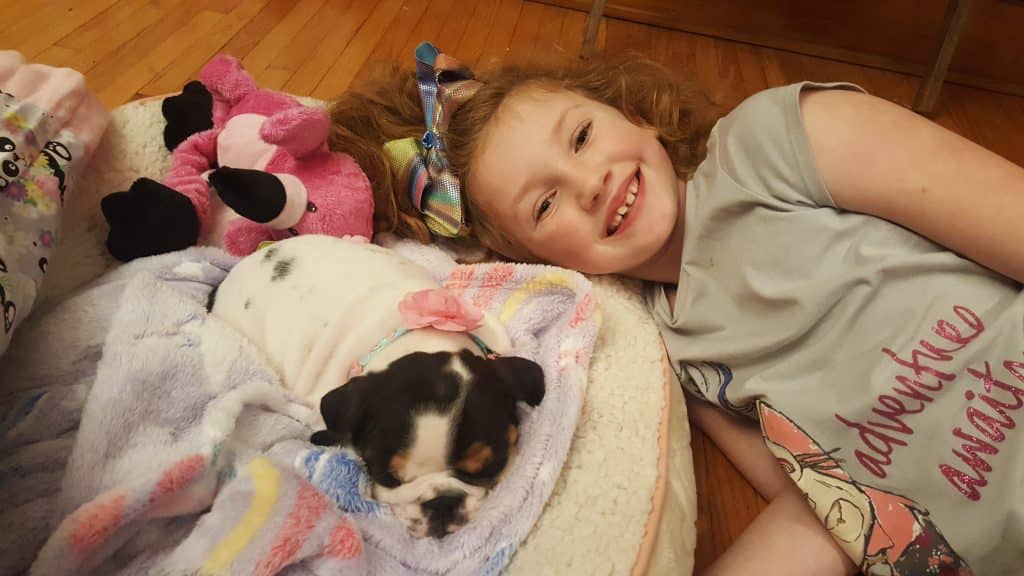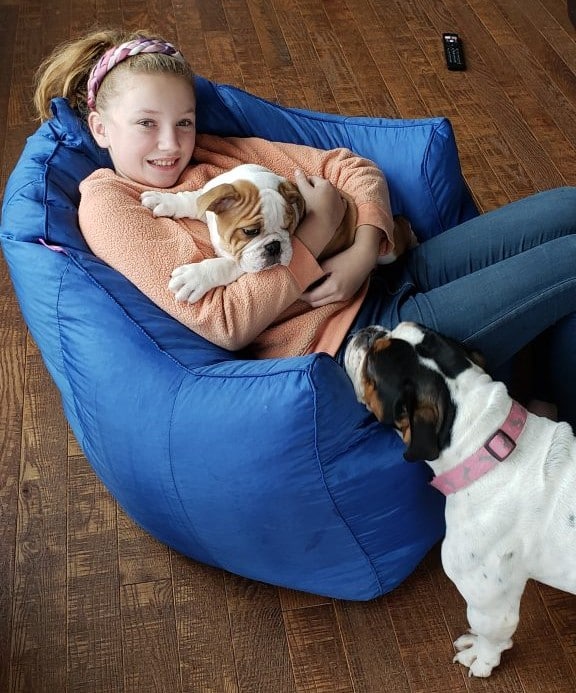The Proper Use of a Crate and Your Bulldog


The Proper Use of a Crate and Your Bulldog
Crating Philosophy
When considering the natural habitation of a canine, often its home is a den, cave, or similar close-quartered shelter. They used this space as their home, to sleep, escape from danger, and raise their young. Obviously, your bulldog would not appreciate roughing it out in the wild.
On some days, it feels like our bulldogs have decided to claim the entire house as their den. But, we know they find comfort and in their crate as an escape from the clamor of a busy house.
Certainly, the crate can be a great tool and outlet for your bulldog IF used properly. As useful as crates can be they are often one of the most abused resources an adopter. There is much, unneeded controversy on using them that has stemmed from irresponsible dog owners abusing their purpose. As concerned bulldog breeders, we make sure to take the time to explain to our adopters the proper and improper uses of a crate.
Introducing the Crate
Introducing your bulldog puppy to the crate should be a gradual process. Start by placing the crate in a central location within your home, such as the living room or kitchen, where your puppy can observe the household activities. Leave the crate door open and entice your puppy to explore it using treats or toys. Encourage positive associations by placing their favorite blanket or toy inside the crate.

Addressing Whining or Barking
It’s not uncommon for bulldog puppies to vocalize their displeasure when first introduced to crate training. However, it’s essential to resist the urge to give in to their demands or comfort them excessively, as this may reinforce the behavior. Instead, wait for a moment of quiet before providing attention or letting them out of the crate. Consistency is key, and over time, your puppy will learn that quiet behavior results in positive outcomes.
Proper ways to use a crate:
Nighttime Crate Training
Nighttime crate training is particularly important for bulldog puppies, as it helps prevent accidents and promotes a good night’s sleep for both you and your puppy. Place the crate in your bedroom initially to provide comfort and reassurance to your puppy. As they grow more accustomed to their crate, gradually move it to its permanent location elsewhere in the house. Ensure your puppy has had ample opportunity to eliminate before bedtime and avoid leaving food or water in the crate overnight. Once your bully is completely potty trained it is ok to sleep outside the crate, but we have found they often prefer their crate as a place of comfort as they grow older.

New Litter Updates
Be the first to know about new litters and puppy pictures.
Utilizing Crate Training for Housebreaking
Crate training can be a valuable tool in the housebreaking process for bulldog puppies. Dogs naturally avoid soiling their sleeping area, making the crate an effective means of teaching bladder and bowel control. Supervise your puppy closely when they’re outside the crate, and take them outside to eliminate immediately after meals, naps, and play sessions. Praise and reward them lavishly when they go outdoors, reinforcing the desired behavior.

Establishing a Routine
Creating a structured routine is essential for helping your bulldog puppy acclimate to their crate. Designate specific times for meals, bathroom breaks, playtime, and crate time. As puppies thrive on predictability, a consistent schedule will help them feel secure and confident in their environment. Incorporate short crate sessions throughout the day, gradually lengthening the duration as your puppy becomes more accustomed to their crate.
Limit access to the house while you aren’t home (for short periods of time)
While starting the potty training process and as you build trust in your bulldog, you should control any unsupervised time by crating him/her. With that being said you should LIMIT the amount of time that your bulldog spends in their crate. We like to use the 4-hour rule at our house for an adult bulldog and the 2 hour limit for our puppies. Any time past these limits, we would seriously consider arranging someone dropping by the house to let them out and play.

Transporting your bully in the car
A crate provides a safe place for your bully to travel with you in the car (especially long trips). We have found they love to snooze in their crate when road-tripping with us.
Escaping from too much commotion
The crate should be a place that your bulldog voluntarily goes into; they should feel that the crate is their home! Crates are an escape haven for your bulldog when the house is busy and there is just too much commotion.
What a crate is NOT to be used for
Punishment
We cannot repeat this enough! Do not use it as punishment for your bulldog! The crate should be a place that your bulldog likes going and if you use it for punishment they will not want to go there.
Long periods of time
Puppies under six months of age shouldn’t stay in a crate for more than a few hours at a time. They cannot hold their bladder that long and they should not be expected to! A crate is not a way of life for a dog, if you are working 8-10 hours a day, coming home and letting your bulldog out for a few hours and then putting them back in their crate for 8 hours of sleeping you are not being fair to your bulldog.
Eventually, behavioral issues will start to show simply from a lack of attention. If being home all day is not an option for you and you have to crate your bulldog we encourage you to look for another option… possibly having a family member dog sit, adjust your schedule or look for a trustworthy doggie daycare.

Crating caution!
Remember that a crate is a tool for training NOT a way of life! This isn’t a magical solution. If not used correctly, a dog can feel trapped and frustrated.
Check Out our Available Puppies Here

Bruiser Bulldog’s Reviews
